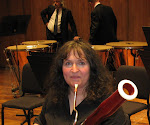The Firebird ballet is based on Russian folk tales involving a magical glowing bird (the firebird), which is both a blessing and a curse to its captor. The Firebird, premiered 100 years ago in Paris, is historically significant not only as Stravinsky's breakthrough piece with both the public and the critics, but also as the beginning of the collaboration between Stravinsky and Diaghilev (founder of the famous Ballet Russes). After The Firebird premiered, there were immediate talks of a sequel, leading to the composition of Petrushka and later The Rite of Spring.
For years there has been disagreement among bassoonists regarding a particular note in the famous bassoon solo of the Berceuse, or Lullaby, of the Firebird Suite. As far as I am concerned, the debate is resolved by this video of Stravinsky conducting the Berceuse. Although I was taught to play D natural, this time I played D flat in the famous spot:
I think it's safe to assume that the bassoonist in Stravinsky's video is playing the note choice (D flat) which was approved of by the composer himself. Our conductor this week, Joana Carneiro, did not flinch when I played D flat, and I'm sure that she was listening closely.
Of all of the bassoon solos in the orchestral literature, I have played this one the most frequently. We've played it on pops concerts, summer concerts, runouts, and school programs as well as classical subscriptions. One would think that such familiarity would have rendered the solo easy by now, right? Wrong!!
First of all, it's daunting to be given the responsibility for rendering any solo, never mind one of the most famous gems in the orchestral literature. This particular solo happens to start on and be centered around what I consider the most unstable note on the bassoon: Bflat 3. Any tension on the part of the bassoonist will result in a sharp Bflat. Try too hard to compensate, and the player easily ends up with a flat Bflat! F3, another important note in the solo, tends to sound weaker than the surrounding notes, which is the opposite of what the solo calls for.
When I prepare this solo, I always think of the words of my teacher K. David Van Hoesen. He used to speak of moving the fingers as if molding clay for a lyrical solo. Indeed, finger motion is integral to this smooth, calm, lugubrious lullaby.
To deal with my top priority of playing the solo in tune, I practice against a Bflat drone. It's important to be sure that the temperature of one's practice space is close to the temperature of the stage. That's a challenge for me because our stage is often too hot, which of course raises the pitch of the bassoon.. And because of that, I really can't make any final reed decisions at home. Only onstage can I be sure of a reed's pitch level.
Sound is also critical. I don't even consider reeds which lack the sound I'm looking for, so the only reeds I test for pitch are the ones which have already passed the sound test. Yes, I go through a lot of reeds! I reject reeds which sound harsh, thin, buzzy, bright or raucous. I prefer reeds which produce a strong and appealing sound throughout the range.
We performed the 1945 version of the Firebird Suite. This was my first encounter with this version, and it included some interesting bassoon parts, especially in the Pas de Deux::
If you'd like to hear the Columbus Symphony's performance from last weekend which included the 1945 Firebird, it can be accessed here on InstantEncore.
.
This is The Record of John
-
Our sermon today used this passage so it was fun to land on this. Orlando
Gibbons: This is the Record of John The Gesualdo Six From the YouTube page:
The G...
7 hours ago









6 comments:
how do you learn tenor cleft? and how are you able to hit those super high notes,like past the 3 octave G?
Yarvoh, I learned tenor cleff during my first few months of playing the bassoon when I was a kid. Usually it happens out of necessity, as in my case. The orchestra director of the summer program I was in gave me a bassoon solo piece he wanted me to play with orchestra accompaniment, and it had tenor clef. My teacher taught me how to figure out the notes. For fingerings, you need a resource, like this http://idrs.org/resources/BSNFING/FINGHOME.HTM
Good luck!
Betsy
Do you know of a brand of bassoon reeds that has both good sound in the top and bottom of the bassoon's register? Many thanks for any ideas :)
Dear Anonymous,
It's very difficult to find a reed that has a good low register AND a good high register. I've made a few in my lifetime, but I attribute it to good cane! (Luck, in other words.)
This is the website of a highly regarded reed maker that professionals use:
http://www.kv191.nl/
Good luck!
Betsy
I've always wanted to play the lullaby solo with full orchestra...
Yarvoh- I think of tenor cleff as taking the written notes up an octave in treble cleff then down a step. Works well for me.
The main high notes I struggled with were e flat and e above that g, and my teacher always said firm corners and extremely focused air.
Anonymous- If you have a teacher/know a teacher who makes one you should buy theirs, because the store bought machine-made ones are just awful. In the long run, i've found it easier and better to make my own reeds.
This was great help thank you, I'm playing this in SCSBOA honor orchestra and had a huge number of problems that were resolved.thanks to you!!!
Post a Comment